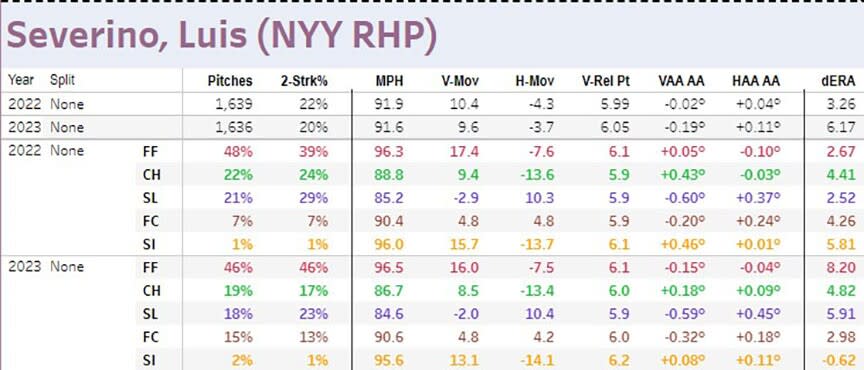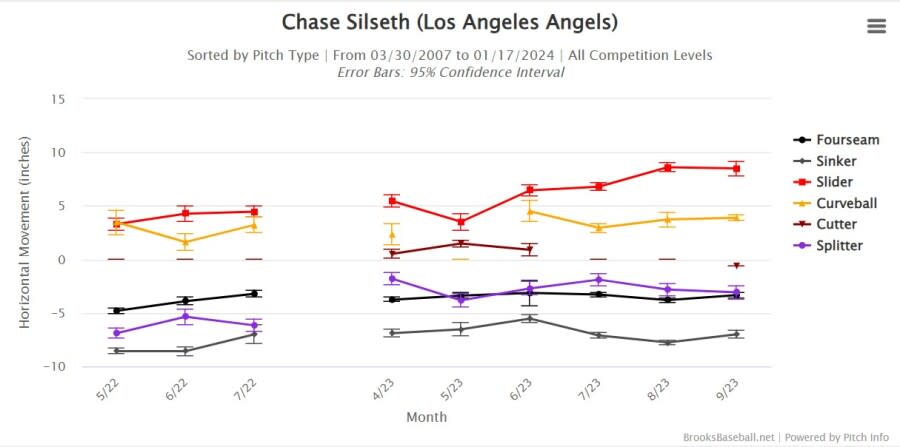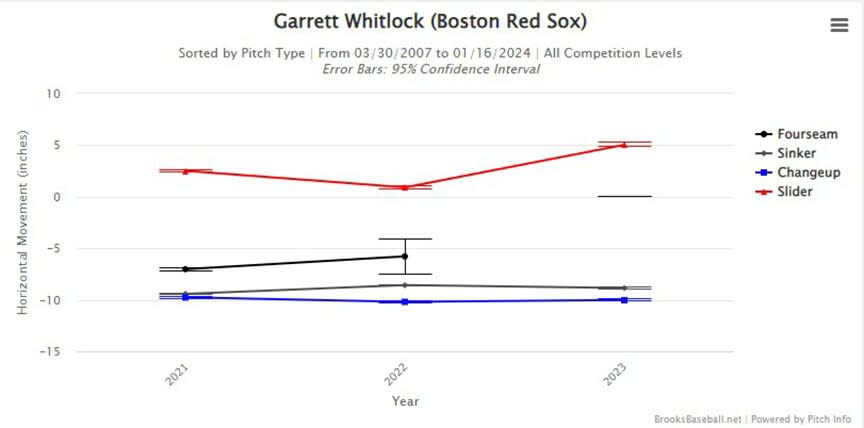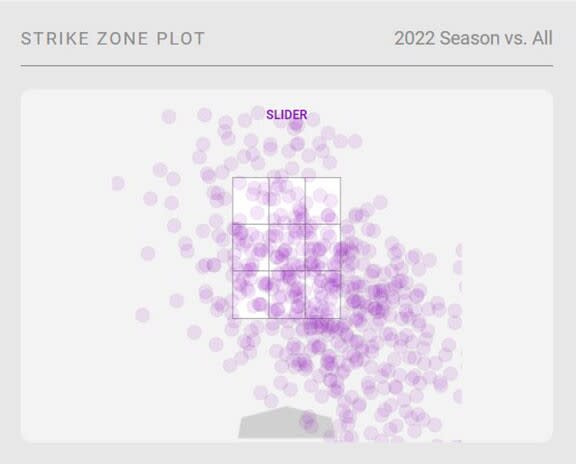Fantasy Baseball: Late Round Starting Pitcher Targets in 2024
Fantasy baseball draft season is picking up, so it's time to start diving into a little starting pitching strategy. As I've mentioned on Twitter a few times and wrote about in the Rotoworld Fantasy Baseball Draft Guide (headed to publishers now), the starting pitching landscape has been altered by both last year's poor performance from some top-20 arms and also the plethora of injuries to perennial early-round starters. That chaos at the top of starting pitcher rankings has not only led to fewer "safe" options early, but it has caused some of the safer late-round arms to be pushed up inside the top 300 as people who feel uncomfortable with their rotations hope to steal a safe arm late.
So how do we respond to that late in drafts? In this article, I'm going to look at some of my favorite starting pitcher targets going outside the top-300, which means after round 25 in 12-team drafts and after round 20 in 15-team drafts.
Generally speaking, your rotations should be filled by this point in drafts, regardless of whether you're in a 12 or 15-team league, so we should really be looking for upside with these selections. Given that we've accepted over the years that we're going to use the waiver wire often for starting pitching, it doesn't really make sense to take a "safe floor, low upside" starter this late because those guys will always be on the wire. We'd rather take a starting pitcher who has risk but could become an every week option for us if things break right.
As a result, the types of arms I look for late in drafts are pitchers who have upside and paths to success that I can determine quickly. What I mean by that is that I want to take chances on players where, two weeks into the season, I can determine if my optimism was misplaced or not and simply move on to a strong performer from the first few games rather than hold a questionable pitcher on my bench for weeks. To me, that leaves three categories I shop in:
1) Injured pitcher who I hope will bounceback
2) Pitchers who made clear second half changes I want to see if they can build on
3) Young pitchers with a clear path to growth if they make one or two changes in the offseason
In all of the above instances, I'll know after spring training and a couple regular season starts if they look healthy or have made/sustained the changes I was hoping to see. If not, I can move onto another option.
After all that, it's time to get into my favorite options.
All ADPs are from NFBC drafts from December 1st to January 16th (150 drafts).
Edward Cabrera - Miami Marlins (ADP: 303)
The case for Cabrera is simple: He's 25 years old with elite fastball velocity, an electric change-up, and the ability to miss bats with a 13.4% swinging strike rate (SwStr%) and 27.2% strikeout rate. The negative for Cabrera is also simple: he walks far too many people and misses spots way more often than you'd like to see.
Of course, since you're drafting him outside the top 300 picks then his command risk is already baked into the cost. What we want to focus on here is why his potential upside is worth a gamble as one of your bench arms to start the season.
For starters, the changeup really is elite. It boasted a 19.9% SwStr% and 71.6% groundball rate in 2023, which means it's either missing bats or getting ground balls. He consistently keeps the pitch away from lefties but also has a 19.1% SwStr% and .184 xBA against when he throws is to righties, which he actually does 29% of the time. Cabrera also leaned on the pitch more as the season went on, and when pitchers throw their best pitch more, we're happy.
We also saw Cabrera's four-seam take a step forward after a stint in the minors over the summer. Before being sent down, his four-seam allowed a 15.9% barrel rate and posted a 4.79 Defense Independent ERA (dERA). After coming back up, the pitch had a 7.1% barrel rate and 1.32 dERA. It also allowed a significantly higher launch angle on batted balls, which leads me to believe that Cabrera was consistently getting the pitch up in the zone more, which we'd love to be true. The pitch itself has elite velocity, above average extension and arm-side break and average IVB, so if he does keep it up in the zone, it has the potential to be a strong offering to pair with his change-up and could be a difference-maker for him.
Cabrera also doesn't allow a lot of hard contact, with just a 6.9% barrel rate allowed and 30.9% ICR (Ideal Contact Rate), which is barrels + solid contact + flares/burners divided by batted ball events. His ICR was among the best in baseball. He has no major lefty/righty split concerns and rounds out his arsenal with a curveball that misses bats with a 14.4% SwStr% and can be a solid supplemental offering and a sinker that has the ability to be a solid groundball pitch if he could throw it in the zone more often.
That all shakes out to a pitcher whose raw stuff is good enough that he's never really been hit hard despite not showcasing great command. If the command does improve or those second-half four-seam gains carry over, you could be looking at an impactful arm in fantasy leagues. If there is no real growth, he's just a frustrating arm that never really torpedoed your stats.
A final criticism of Cabrera is that his shaky command may mean that he's best suited as a multi-inning reliever. While, I understand that argument, I also think he could still have plenty of fantasy value in that role. Last season, he made two appearances as a "follower" out of the bullpen after being recalled from the minors - at home against the Dodgers and on the road in Milwaukee. In those two games he went 1-0 while allowing two hits and two earned runs in 8.2 innings with 13 strikeouts. He also walked eight. It's not ideal, but the "follower" version of Cabrera could actually pitch four to eight innings a week, racking up solid strikeout totals and potentially earning wins. If that's the downside, that's not really so bad in deeper formats.
Luis Severino - New York Mets (ADP: 305)
This pick is entirely based on the internal logic of "There's no way he could have really fallen off that hard; is there?" No, there's no real data to support that, but sometimes you just look at a pitcher's performance in a given season and have a feeling that it can't be for real.
Severino became a full-time starter with the Yankees before the 2017 season. Since then, he had never posted an ERA worse than 3.39 in a season. He had never posted a strikeout rate worse than 27.7%, and he had never allowed more than 41% hard contact (and that came in his up-and-down 2022 season). So what happened in 2023?
Well, there is argument that he only threw 18 combined innings from 2019-2021 due to injury and then the Yankees cut his season short in 2022 after 102 innings. That could lead to rust or lack of confidence or even frustration, as Severino spoke openly about being upset with the organization after the 2022 season. Any of those things could have impacted his mentality when stepping onto the mound. He could have also experienced bad luck, thanks to a career-worst .326 BABIP or career-worst 65.9% left on base rate, meaning runners that he allowed on base scored at a higher clip than ever before in his career.
The other, potentially more realistic, argument is that Severino totally lost his fastball in 2023. Despite throwing the pitch 96.5 mph (which is a decent indicator of health), the induced vertical break (IVB) on the fastball fell from 17.4 inches to 16.0 inches. That's a big deal. (The chart below from Alex Chamberlain's Pitch Leaderboard has it measured in V-Mov or Vertical Movement).

IVB on a fastball is also what has commonly been referred to as "ride" or "rise" where the spin rate and efficiency on the pitch almost makes it appear to rise because it has positive vertical break when you control for the effects of gravity; basically meaning that it doesn't drop like a projectile should over time. Fastballs that are below 14 or 15 inches tend to have more horizontal break or run to compensate; however, Severino's fastball in 2023 didn't do that either. So it didn't "rise" or "run" which means it was relatively "flat" and resulted in a 14.1% barrel rate allowed, an 8.20 dERA, and a 36.8% ICR. All of which is to say, Severino's fastball was hit hard in 2023.
That caused him to rely on the cutter more and also meant that he was unable to get ahead of hitters as often, which led to more hitter's counts and fewer strikeouts, etc. Now, it is possible that the injuries simply caused him to "lose" his fastball? Sure, but he didn't lose it in 2022, so why 2023? It feels more likely that it's a mechanical issue that Severino can fix in the offseason, and the good news is that, with Rapsodo tracking at most spring training complexes, we should know early on if he has his IVB back on his fastball. Considering Severino is already at Driveline this offseason, I feel like it's a pretty solid bet that this will be the case, so it could be wheels up for another mid-3 ERA season and a 27% strikeout rate.
Jameson Taillon - Chicago Cubs (ADP: 306)
I need to give a hat tip here to Nick Pollack from Pitcher List, who has talked me into Taillon at this cost. You should also watch Nick break down one of Taillon’s starts with Taillon himself because it provides a lot of insight from Taillon into what his thought process is for his approach and pitch mix. That can often provide more insight than any of the analysis we can do with charts, data, and game watching.
In the interview I linked above, Taillon mentions struggling with his cutter early in the 2023 season, adding a sweeper instead of more of a gyro slider, and having a hard time finding a rhythm due to injuries. In the first half of the year, Taillon was still incorporating his old slider a bit because, as he said to Nick, he went into the season not at all comfortable with the sweeper and had to think about mechanics instead of throwing it with confidence. Also, his cutter allowed a 10.3% barrel rate with a 6.92 dERA, and his curve was allowing a 26.9% barrel rate.
Yet, we saw him make clear changes as he got healthier and found more comfort with his new pitch mix. In the second half of the season, his cutter reduced the barrel rate and improved to a 4.30 dERA, he found more comfort with the sweeper, posting a 15.2% SwStr% and finding the zone more often, and his curveball stayed low in the zone more, which led to an improved 7.8% barrel rate.
In fact, from July 1st on, Taillon had a 3.57 ERA, 1.11 WHIP, and 16.8% K-BB% in 16 starts. Those are solid results when we know that they came with some intentional changes and growth. There's also some additional room for growth because Taillon is aware that he can still improve versus lefties, saying to Nick, "To lefties, I need a pitch that I can throw below the zone consistently." In the video, Taillon mentions that, even if the pitch doesn't miss bats, you want to give MLB hitters different looks, especially on the outside part of the plate, so that they can't step into the box prepared to clear their hips and yank the ball. He wants them to have to go back into the dugout questioning how they want to approach him the next time up.
In 2023, he allowed a .266 average and .514 slugging percentage to lefties with 18 home runs allowed. Against righties, he allowed a .252 average and .376 slugging percentage with nine home runs. Now, Taillon is using this offseason to add a split or split-change that he can use against lefties, which means the second half version of him could be the version we see in 2024 and that's pretty good at this cost. He may not have the upside of some of the other names on this list if things "click," but he may also have a safer floor and have fewer changes to make to be fantasy-relevant for your squad.
Chase Silseth - Los Angeles Angels (ADP: 346)
This is a little bit of a situation where I am dreaming on potential growth rather than having as much to go off of like I did with Taillon. However, we did see important changes from Silseth last year. For starters, Silseth boasts a strong prospect pedigree as an 11th round draft pick in the 2021 draft out of the University of Tennessee. A little over a year after being drafted, he made his MLB debut last season with the Angels but it did not go well, posting a 6.59 ERA across seven starts. The 2023 season started off on a similarly inauspicious note with Silseth getting called up from Triple-A in late April so the Angels could use him as a multi-inning reliever. He threw five shutout innings before being lit up for seven runs in his next two appearances, and then the Angels debated turning him into a late-inning reliever.
However, Silseth's potential trajectory changed when the team allowed him to keep starting in Triple-A, where he posted a 2.79 ERA thanks, in part, to a re-shaped slider. When he was up earlier in the year, Silseth was throwing his slider 84.7 mph with 10 inches of horizontal run and -4.6 inches of drop. When Silseth came back up for the start against the Yankees, he was throwing a slider that was just 80.6 mph with 11 inches of horizontal movement and -10.6 inches of drop that almost acted like a sweeping curveball.

The introduction of that slider has the potential to be a massive game-changer for Silseth. While his second half sample size was a small one (after being hit by a comebacker in a scary moment), the new slider had a 1.74 dERA and 16.7% SwStr%. Assuming he continued getting comfortable with it during the offseason, that would give him a potential plus pitch to go along with splitter that had a 0.79 dERA and 20.9% SwStr% in 2023 but lacks consistency.
He would then just need to land on a fastball that works best for him. His four-seam has good velocity at 95 mph and average IVB, but he doesn't locate it up in the zone as much as we'd like, and his sinker is more of a groundball pitch that had a 5.23 dERA last year. Still, at just 23 years old, Silseth has time to continue to tweak his arsenal to build around the slider/splitter combination and if we see that growth show up in spring training then we can fully get on board.
Garrett Whitlock - Boston Red Sox (ADP: 422)
The beauty of taking a gamble on Whitlock is that it will be so incredibly easy to know if you should hold him on your roster or cut him. The Red Sox are stretching him out to battle for a spot in the rotation with Tanner Houck, Kutter Crawford, and maybe Josh Winckowski. Unless the Red Sox add another arm, two of those players will make the rotation. If Whitlock does the things I mention below that I like about his profile, he'll be in the rotation out of the spring and you'll be happy you drafted him at this price. If he doesn't do these things, he won't win a rotation spot and you either won't draft him or you'll cut him for somebody who does look good in spring.
It's an easy decision and we like those.
On some level, I want to throw out much of 2023 for Whitlock since he was on and off the injured list a few times, which caused Boston to shift him into various roles in the bullpen. Now, some people believe that Whitlock isn't cut out for the rotation, but he was a starter in the Yankees organization in 2018 and 2019 and threw as many as 120 innings in the minors in a season. If we believe Michael King can be a starter due to previous minor league workload then we should be open to the idea that Whitlock can too, especially since he threw 78.1 innings in 2022 and 71.2 innings in 2023, which is pretty close to what King has been putting up recently.
When healthy, Whitlock is a sinker/change-up pitcher with good arm-side run on both pitches. He frequently attacks with the sinker up and change-up low and uses the change as a key swing-and-miss pitch to lefties with an 18.8% SwStr% overall. However, he seemed to lack feel for the pitch in 2023, getting too much of the plate, which led to hard contact.
Another major change for Whitlock in 2023 is that he modified his slider from more of a gyro slider to a sweeper with almost eight inches more horizontal movement.

While that pitch had a 20.2% SwStr%, he also threw it in the zone just 33.6% of the time, which means he simply couldn't command it and that meant he had no putaway pitch for right-handed hitters, which is not a good thing.
But here's the narrative for Whitlock at this price: he has great shape/movement on all three pitches and an arsenal that works to both righties and lefties. Injuries in 2023 led to inconsistent performance and, more specifically, multiple injury stints made it hard for him to get the feel for a new pitch that he had just added to his arsenal, which is why he never had consistent performance from the slider (much like Taillon discussed in his interview). With a fully healthy offseason under his belt, Whitlock will be even more comfortable with the slider and go back to being the well-rounded pitcher we saw in previous seasons, who could produce solid value in 120 innings for a good but not great team.
Or, his slider still looks terrible in the spring and he is sent back to the bullpen and you move on.
Aaron Ashby - Milwaukee Brewers (ADP: 432)
Many people were enamored with Ashby after he debuted in 2021 and posted a 4.55 ERA in 31.2 innings but also showed off a 97 mph fastball from the left side en route to a 29.3% strikeout rate and 13.3% swinging strike rate. However, Ashby failed to take a big step forward in 2022 then got hut and missed all of the 2023 season, so his placement in this article is simply putting ourselves in a time machine to head back two years and remember what was enticing about him before the injury.
For starters, in both 2021 and 2022, his slider was an elite swing and miss pitch with a SwStr% of 18% or better in each season. He also flashed the ability to miss bats with his change-up, which posted a 15% SwStr% or better in each season as well. He also limited hard contact in both seasons with an elite 25.9% ICR in 2021 and a more realistic but also damn good 33.4% rate in 2022.
So we have a lefty with plus velocity, two good swing-and-miss pitches, and the ability to limit hard contact. All of that is incredibly enticing. He also only has to beat out Colin Rea or Joe Ross to win a spot in the Brewers rotation, so why is he going this late?
Well, for starters, I do think some people have forgotten about Ashby. Also, his WHIP jumped from 1.17 in 2021 to 1.43 in 2022 as he became more of a full-time starter. Part of that has to do with some natural regression to the mean with his BABIP and left on base rate. However, hitters also stopped chasing his slider out of the zone as much (45.5% in 2021 and 36.9% in 2022), and he struggled to keep it in the zone for strikes. His strike zone plot, which you can see below courtesy of Pitcher List, shows a pitcher who did not have elite command of his best breaking pitch.

He also struggled to keep his change-up low in 2022, throwing it low in the zone just 56% of the time (according to Pitcher List) after throwing it low 65.2% in 2021. He also threw the pitch down the middle of the plate 8.5% in 2022 after doing so just 5.2% of the time in 2021, which is a meaningful difference. Considering his change-up is a crucial weapon against righties, Ashby saw his strikeout rate against righties fall in 2022, while his walk rate and BABIP went up. He's going to need to re-discover the command/location of the slider and change-up for him to be an impactful starter.
However, look at that ADP. We're still talking about a 25-year-old starter with a clear path to a rotation spot who has the upside to be a high-3, low-4 ERA pitcher with strong strikeout rates. That's not a "league winner," but that's a fantasy SP3 or SP4 that you're getting after pick 400. If he comes out in the spring and the slider and change-up look well-located, then I think we should be jumping on board.
Prospects
I'm not a prospect writer myself, so I won't go too deep into detail on the prospect arms that I like in this range, but there are three arms that stick out as players with high-level skill set and the potential to win a starting job out of spring training: Ricky Tiedemann of the Blue Jays, Cade Horton of the Cubs, and Robert Gasser of the Brewers. All three figure to debut in 2024, but there are also obstacles facing all of them debuting before the summer, so I'm hesitant to invest too heavily in them right now.

